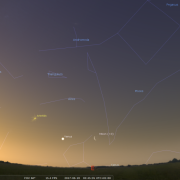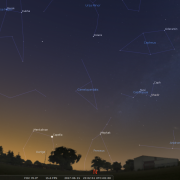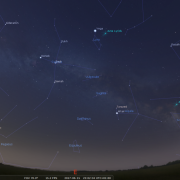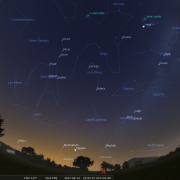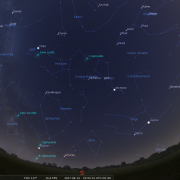Welcome to the WDAS monthly newsletter for June 2017: a digest of the month's latest contributions to our website. Below you'll find Society News, Sky Notes and In-Focus articles printed in full. There's also future events, and trailers for other articles which appear in full on the website - just a click away!
On the website you'll also be able to comment on articles, and if you'd like to play an editorial role in creating new content, just let us know!
Society News
 As you will know Paul Money had to cancel his talk on May 9th due to family illness. Paul sends his apologies and will reschedule as soon as he is able to. Fortunately Paul had given us a couple of days notice, allowing time for cancellation notices to be placed on the website and in the local media.
As you will know Paul Money had to cancel his talk on May 9th due to family illness. Paul sends his apologies and will reschedule as soon as he is able to. Fortunately Paul had given us a couple of days notice, allowing time for cancellation notices to be placed on the website and in the local media.
Mark went up to the college on the night to inform anyone who hadn’t received the news, a beautiful sunny evening as it turned out. Only one person turned up and was disappointed. The time wasn’t wasted however, Mark discussed with the caretaker, James, how to copse the trees on the railway embankment.
Stop Press – We have just heard from Paul who is back on the lecture circuit after his wife Lorraine’s bout of illness. We have said to Paul that post summer is the most likely time, and have furnished him with 5 dates; last two Tuesdays in September as well as 3 dates in October. We shall inform you of the pencilled in date in July’s notes.
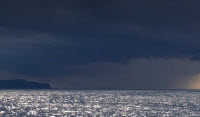 Our planned star party on May 27th from the West Cliff, unfortunately fell victim to the thundery breakdown of what had been a period of fine, settled and warm weather during the week beforehand. (One might accuse the weather nymph of being particularly vindictive.) Thundery rain early evening, followed by cloud cover, meant that little observation would have been possible and reluctantly the event was called off (cloud cover actually became complete).
Our planned star party on May 27th from the West Cliff, unfortunately fell victim to the thundery breakdown of what had been a period of fine, settled and warm weather during the week beforehand. (One might accuse the weather nymph of being particularly vindictive.) Thundery rain early evening, followed by cloud cover, meant that little observation would have been possible and reluctantly the event was called off (cloud cover actually became complete).
Of course, the clouds started to break up around the time we would have been thinking of packing up, had we gone ahead (I did say vindictive). It is a situation encountered many times before, and no doubt will happen again; but it’s still frustrating all the same. Let’s hope we have more luck for the event on the 3rd when the moon will be visible as well as Jupiter and Saturn.
Cosmology Corner
Many WDAS Members will have heard Sean Paling’s talk about hunting for Dark Matter in Boulby Mine, and followed updates of how successive experiments are progressing. So let’s take another look at Dark Matter: why we think it’s there and what it is.
Why Dark Matter?
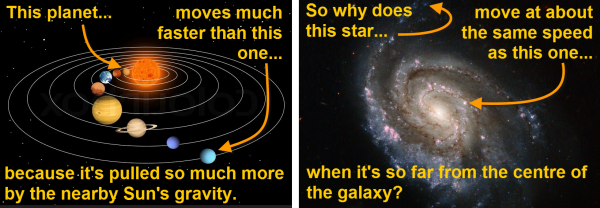
In our own solar system Mercury is moving faster than Earth, and Earth faster than Neptune. That’s because their speed is a measure of the Sun’s gravitational pull, which is stronger the closer you are to it. Hallelujah… the laws of physics are working!
But wait, the stars at the edge of a galaxy rotate around the super-massive blackhole at its heart, at more-or-less the same speed as stars much closer in. That should be impossible! In fact, galaxies are rotating so fast that – by rights – they should be flying apart. Unless… there’s a whole lot more mass spread around the galaxy that we can’t see. What would be a good name for it..?
And since that discovery, the evidence for Dark Matter has just been piling-up. Everything, from the evolution of the entire universe to the leftover signals from the Big Bang, seems to scream, “DARK MATTER.” Astronomers are now able to model the Universe and put a figure on how much of it there is… about 84% of actual matter in the Universe is Dark Matter. And since it responds to gravity, we can also map its location and its speed, and we find it’s actually shaped the Universe. Yes, Dark Matter is responsible for the large-scale filament structure of our Universe.

So what’s it actually made of? Well, there have been various ideas:
1. MOND (Modified Newtonian Dynamics)
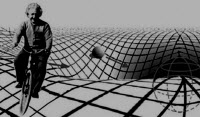 At first it was thought that maybe gravity didn’t work the way Einstein told us, and there are some cosmologists who have tried to tweak the laws of gravity to fit our observations. The trouble is, successive discoveries keep shooting holes in their maths! Most cosmologists accept that Dark Matter is out there and want to understand what it is.
At first it was thought that maybe gravity didn’t work the way Einstein told us, and there are some cosmologists who have tried to tweak the laws of gravity to fit our observations. The trouble is, successive discoveries keep shooting holes in their maths! Most cosmologists accept that Dark Matter is out there and want to understand what it is.
Some ideas come from “old physics” (the stuff we already know about) and others from “new physics” (exotic stuff we haven’t discovered yet).
2. Old Physics: Regular Matter
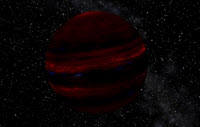 There’s lots of stuff in the universe that doesn’t glow, and it’s really tough for us to see. Black holes (of course), but also neutron stars or brown dwarfs: based on a survey of our very local galactic neighbourhood they are far more numerous than ‘real’ stars. Together all these dark objects are called MACHOs: Massive Compact Halo Objects. (Halo?? Well, you know how it is!) The problem is, we can’t scale-up our local observations to anywhere close to the amount of “missing matter”.
There’s lots of stuff in the universe that doesn’t glow, and it’s really tough for us to see. Black holes (of course), but also neutron stars or brown dwarfs: based on a survey of our very local galactic neighbourhood they are far more numerous than ‘real’ stars. Together all these dark objects are called MACHOs: Massive Compact Halo Objects. (Halo?? Well, you know how it is!) The problem is, we can’t scale-up our local observations to anywhere close to the amount of “missing matter”.
3. Old Physics: Neutrinos
 Here’s an attractive idea: neutrinos have hardly any mass at all, they don’t emit light, they’re devilishly difficult to detect, and absolute squillions of them were made in the Big Bang, not to mention inside stars (and even a few made inside of you!) The problem is, neutrinos move wayyy to fast to clump together the way we’ve seen dark matter clumped together in huge structures like galaxies.
Here’s an attractive idea: neutrinos have hardly any mass at all, they don’t emit light, they’re devilishly difficult to detect, and absolute squillions of them were made in the Big Bang, not to mention inside stars (and even a few made inside of you!) The problem is, neutrinos move wayyy to fast to clump together the way we’ve seen dark matter clumped together in huge structures like galaxies.
4. New Physics: WIMPs (Weakly Interacting Massive Particles)
 These are the things Sean’s team is looking for in Boulby Mine (along with various other teams across the world). Apart from being, by definition, hard to detect, another problem that the form of WIMPS isn’t well defined. For example, we’ve little certainty about their likely size. For this reason, it’s taken a long time to search through all the different possible types of WIMP, and by now the bigger problem is that we’re getting close to ruling out all likely forms of WIMP without finding a trace. So, as I asked Sean at Astromeet, “if not WIMPs, then what?”
These are the things Sean’s team is looking for in Boulby Mine (along with various other teams across the world). Apart from being, by definition, hard to detect, another problem that the form of WIMPS isn’t well defined. For example, we’ve little certainty about their likely size. For this reason, it’s taken a long time to search through all the different possible types of WIMP, and by now the bigger problem is that we’re getting close to ruling out all likely forms of WIMP without finding a trace. So, as I asked Sean at Astromeet, “if not WIMPs, then what?”
5. New Physics: New Neutrinos
 Some cosmologists think there might be a new kind of super-heavy neutrino that we just haven’t detected yet, because you wouldn’t need as many heavy neutrinos to account for dark matter as you would light neutrinos. So far, however, none of have been spotted.
Some cosmologists think there might be a new kind of super-heavy neutrino that we just haven’t detected yet, because you wouldn’t need as many heavy neutrinos to account for dark matter as you would light neutrinos. So far, however, none of have been spotted.
6. New Physics: Axions (from the Greek ἀξίωμα – “that which is thought”)
 Axions are about as exotic as it gets: hypothetical particles, postulated to resolve a problem in a branch of quantum physics. If they exist, and if their mass is within a particular range, they could be responsible for Dark Matter. But that’s a couple of big Ifs.
Axions are about as exotic as it gets: hypothetical particles, postulated to resolve a problem in a branch of quantum physics. If they exist, and if their mass is within a particular range, they could be responsible for Dark Matter. But that’s a couple of big Ifs.
7. New Physics: Supersymmetry
 The idea that every particle in the Universe has a kind of heavy twin, and that one of those twins would be dark matter. The famous Large Hadron Collider (LHC) at CERN in Geneva looked hard for them, but failed to spot them within its original power range. After major upgrades, it was turned on again at the end of April 2017 and the search continues. (I’ve detected more doubt than optimism among scientists that they’re going to find their quarry.)
The idea that every particle in the Universe has a kind of heavy twin, and that one of those twins would be dark matter. The famous Large Hadron Collider (LHC) at CERN in Geneva looked hard for them, but failed to spot them within its original power range. After major upgrades, it was turned on again at the end of April 2017 and the search continues. (I’ve detected more doubt than optimism among scientists that they’re going to find their quarry.)
8. New Physics: Parallel Universes
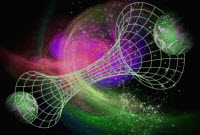 Yes, there are even some researchers who think we’re seeing the effects of parallel universes messing with ours. But, again, there is no direct evidence for any of these new ideas.
Yes, there are even some researchers who think we’re seeing the effects of parallel universes messing with ours. But, again, there is no direct evidence for any of these new ideas.
So, where does that leave us:
- No-one has seen a super-heavy neutrino
- No-one has seen an axion
- No-one’s supersymmetric twin
- No-one has seen a parallel universe
- Most forms of WIMPs also ruled-out
- Experiments have ruled out the simplest models of heavy neutrinos and supersymmetry
- Axions have been ruled-out as an explanation for at least the majority of dark matter out there
- Not enough MACHOs (by far) to account for the mass and regular Neutrinos are far too fast.
So for now, we’re stuck.
Cosmologists around the world are working as hard as they can to understand dark matter better, from the ones staying up all night at the telescope to the ones staying up all night at the blackboard. But as it stands right now, the vast majority of the matter in the universe remains a complete mystery.
The video and inspiration for this article was brought to you by YouTube channel "SciShow Space". You can support their work creating videos that help to teach the world about astronomy by sponsoring a dollar or two per month via their Patreon page.
Sky Notes
In this month's Sky Notes:
Planetary Skylights

 Jupiter dominates the late evening sky, an unmistakeable object riding to the south in the constellation of Virgo not too far above its chief star Spica. Observations of the largest planet in our solar system are always rewarding, even with a small telescope. Look for the dark banding across the disk, the Galilean moons; the configuration of which alters each night, discernable even over the course of several hours, and if you posses a slightly larger telescope, look for the great red spot. This oval feature is an Earth sized hurricane type storm, present on Jupiter for the last 400 years. Its appearance can change; sometimes looking paler and smaller (as in recent years), but always fascinating to look out for. Due to the quick rotation of Jupiter the GRS is not always facing our direction, so don’t be disappointed if you cannot spot it. View from June 10-12th when it is visible around 11pm on the southern equatorial belt. The Moon lies nearby Jupiter on the 3rd and 30th.
Jupiter dominates the late evening sky, an unmistakeable object riding to the south in the constellation of Virgo not too far above its chief star Spica. Observations of the largest planet in our solar system are always rewarding, even with a small telescope. Look for the dark banding across the disk, the Galilean moons; the configuration of which alters each night, discernable even over the course of several hours, and if you posses a slightly larger telescope, look for the great red spot. This oval feature is an Earth sized hurricane type storm, present on Jupiter for the last 400 years. Its appearance can change; sometimes looking paler and smaller (as in recent years), but always fascinating to look out for. Due to the quick rotation of Jupiter the GRS is not always facing our direction, so don’t be disappointed if you cannot spot it. View from June 10-12th when it is visible around 11pm on the southern equatorial belt. The Moon lies nearby Jupiter on the 3rd and 30th.

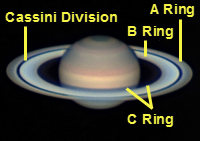 Jupiter may dominate the evening sky, it is however Saturn which takes the plaudits in June, coming to opposition on the 15th and therefore visible all night, admittedly an observing window barely amounting to 4hours at this time of year. As twilight deepens look for Saturn low in the southeast residing in the constellation of Ophiuchus. A modest telescope will reveal the glorious ring system, which is orientated favourably at present; however the low altitude of Saturn does mean the observer is looking through more turbulent air close to the horizon. Patience at the eyepiece will ultimately be rewarded when steady seeing moments allow Saturn to snap into sharp and stunning focus. Look for the major gap in the rings, the Cassini division, and remember that the Cassini probe is still orbiting Saturn (until it dives into Saturn’s atmosphere in September) Careful observation will reveal a speck of light close by Saturn, this is Titan, Saturn’s major moon. Our moon lies nearby in the sky on the 9th.
Jupiter may dominate the evening sky, it is however Saturn which takes the plaudits in June, coming to opposition on the 15th and therefore visible all night, admittedly an observing window barely amounting to 4hours at this time of year. As twilight deepens look for Saturn low in the southeast residing in the constellation of Ophiuchus. A modest telescope will reveal the glorious ring system, which is orientated favourably at present; however the low altitude of Saturn does mean the observer is looking through more turbulent air close to the horizon. Patience at the eyepiece will ultimately be rewarded when steady seeing moments allow Saturn to snap into sharp and stunning focus. Look for the major gap in the rings, the Cassini division, and remember that the Cassini probe is still orbiting Saturn (until it dives into Saturn’s atmosphere in September) Careful observation will reveal a speck of light close by Saturn, this is Titan, Saturn’s major moon. Our moon lies nearby in the sky on the 9th.
 Finally, Venus may be located very low in the dawn twilight sky approximately 45 minutes before sunrise. Look for a brilliant object just above the ESE horizon.
Finally, Venus may be located very low in the dawn twilight sky approximately 45 minutes before sunrise. Look for a brilliant object just above the ESE horizon.
The Summer Solstice

The summer solstice in the northern hemisphere falls on June 21st, when the Sun reaches its greatest altitude in the sky on the ecliptic; the path it takes across the sky during a year. The word ‘solstice’ is derived from the Greek for ‘Sun’ and ‘stoppage’. From our perspective the Sun will cease gaining altitude in the sky and will soon retrace its steps, retreating southwards once again as the axial tilt of Earth begins to shift away from the direction of the Sun.
During our summer when the northern hemisphere is inclined towards the Sun, it feels warmer due to the higher concentration of sunlight per unit area. Think of this as being like a spot light directed onto to the palm of your hand, your palm feels hotter under direct radiation, whereas when the light is tilted, the angle reduces the heat intensity. The actual intensity of solar radiation in June is equivalent to approximately 1.2KW of heat for each square metre, although I can recall many a June when the power switch was apparently turned off!
People also wrongly assume that Earth is closer to the Sun at this time of year; in fact the opposite is true. Earth is actually furthest from the Sun on July 4th at almost 95 million miles, nearly 3 million miles more than when at its closest approach in early January. Although known as the longest day, earliest sunrise and latest sunset times do not occur on the summer solstice date. Earliest sunrise falls around June 16th (from Whitby:- 04:25am) whilst latest sunset occurs on June 25th (Whitby:-21:42pm). It is however the duration of useable daylight that does reach a maximum on the 21st, which from our latitude is just over 17 hours. The Sun drops a meagre 12 degrees below the horizon and even nautical twilight is barely reached. (see Twilight and Shadow.)
The position of the summer solstice currently stands on the Gemini-Taurus border but it wasn’t always so. Thousands of years ago it stood before the stars of Cancer in the northern hemisphere, but has subsequently shifted due of the effects of precession, Earth’s slow axial wobble due to the influence of the moon. From our latitude the Sun never gets overhead, reaching just 59 degrees above the southern horizon at midday on June 21st. From locations between 23.5 degrees north and 23.5 degrees south of the equator, the Sun can appear directly overhead, casting no shadows, which astronomers of antiquity duly noted. At that time the summer solstice position stood before the stars Cancer, and eventually the latitude of 23.5 degrees north became known as the tropic of Cancer. Similarly when the Sun reached its southern limit on the ecliptic (the winter solstice) 23.5 degrees south of the celestial equator, it stood before the stars of Capricorn, the origin of the tropic of Capricorn. Perhaps during our epoch more fitting names for the tropics would be the tropic of Gemini and the tropic of Sagittarius! Until next time, clear skies!

Twilight and Shadow
The deepest level of darkness, known as Astronomical twilight, is just one of three levels experienced, the others being Civil and Nautical twilight respectively. However as Earth orbits around the Sun, the duration and intensity of these twilight levels varies a phenomena most noticeable at higher latitudes.
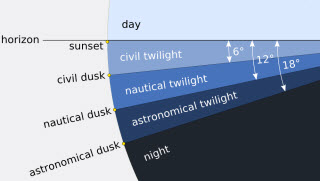 Using evening twilight as an example let me explain further. Immediately after sunset, Civil twilight exists until the Sun is approximately 6 degrees below the horizon. At this point normal daytime activities that require light cease to be possible and ‘lighting up’ time occurs. If skies are really clear an interesting phenomena occurs half an hour or so after sunset, opposite the position of sunset. Look for a hazy, darkish purple band just above the ESE horizon which appears to heap up, before being engulfed by deepening twilight. It is not mist but the shadow of Earth itself, being cast back into space!
Using evening twilight as an example let me explain further. Immediately after sunset, Civil twilight exists until the Sun is approximately 6 degrees below the horizon. At this point normal daytime activities that require light cease to be possible and ‘lighting up’ time occurs. If skies are really clear an interesting phenomena occurs half an hour or so after sunset, opposite the position of sunset. Look for a hazy, darkish purple band just above the ESE horizon which appears to heap up, before being engulfed by deepening twilight. It is not mist but the shadow of Earth itself, being cast back into space!
As the Earth spins a little further round and the Sun’s elevation below the horizon reaches approximately 12 degrees, the marine horizon is no longer apparent and Nautical twilight exists. In the heavens only the brighter navigational stars are visible
Finally, when the Sun drops approximately 18 degrees below the horizon (a hands span) Astronomical twilight commences and the remaining fainter stars become visible. Obviously the faintness of these depends on your local circumstances - it stands to reason someone observing from a dark rural site will see more stars than someone observing from a light polluted urban site. Then, with the approach of dawn the same lighting levels are experienced - only in reverse.
During summer in the northern hemisphere we are inclined towards the Sun and twilight durations alter significantly. At our latitude, for 82 nights from late May until mid August, astronomical twilight is totally absent as the Suns journey beneath the horizon is so shallow it never actually reaches 18 degrees. Matters become worse (for the astronomer) around the summer solstice when even nautical twilight levels barely exist, the Sun setting by a mere dozen degrees. Not surprising then that many astronomers ‘mothball’ their telescopes, waiting for darker skies to return. Some of us persevere; there is always the moon and a bright planet or two to observe.
At least from northern England summer astronomy is just about possible, but as you travel further north nocturnal conditions grow ever lighter and only 13 degrees north of Whitby at latitude 67 degrees N (the Arctic Circle) twilight on any level is completely absent. From here for part of summer the Sun is visible above the horizon 24 hours a day. Only solar observers are completely happy for in the land of “midnight sun” star gazing is limited to just one, that is if it’s not cloudy!
Noctilucent Cloud

With bright twilight now persisting well into the night, observers of the sky should watch out for a particularly beautiful type of cloud formation seen only at this time of year. Known as Noctilucent cloud, these delicate formations appear above the northern horizon, long after sunset, often around midnight. Shining quite brightly, Noctilucent cloud is filamentary in structure, having a characteristic silvery-blue colour. It forms almost exclusively between latitudes 50 and 60 degrees north, high in the upper atmosphere: 50 miles up- five times higher than normal clouds.
The cloud forms when water vapour condenses at the low temperatures that prevail at such altitudes onto particles suspended in the air. More frequent sightings of Noctilucent cloud over the last 40 years may indicate that these particles could be a result of industrial pollution, perhaps from increased air traffic, although the jury is still out on this.
Good observing.
June 2017 Sky Charts
|
Looking North
Mid-June - 23:00h |
Looking South |
|
Looking East
Mid-June - 23:00h |
Looking West
Mid-June - 23:00h |
| Northern Aspect Mid-June - 23:00h |
Southern Aspect Mid-June - 23:00h |
Additional Image Credits:
- Planets and Comets where not otherwise mentioned: NASA
- Sky Charts: Stellarium Software


